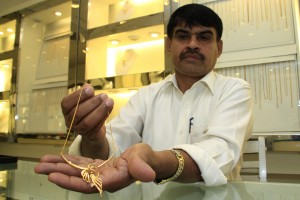Pawning business: Gold mine or mine field?
Sri Lankan banks have pulled the plug on advertising and promoting their pawning business on the back of fast depleting gold prices and an industry exposure of Rs. 700 billion which could prove to be a mine field, industry analysts said.
They estimate total industry exposure to the pawning business together with banks and finance firms and general pawning agencies at Rs. 700 billion. They also point out that banks are generating profit on the pawning portfolio which is not ‘real’ profit, as it’s an asset which is not readily realisable. “This is why the financial exposure is dangerous as it’s not a readily encashable portfolio,” an analyst noted. He said this exposure is increasing and as it stands the banks cannot bring this to a manageable level in a ‘hurry’.

A salesman at a local store displays a necklace. Pic. by Indika Handuwala
He added that this shows how poor Sri Lanka is.“The financial industry has pledged some Rs. 700 billion for people’s day to day consumption without cashflow backing,” he said.
The global price of gold fell from its 2011 peak at more than $1,800 an ounce and dropped by 13 per cent this year. It now hovers at about $1,400 an ounce.
“People’s Bank’s (PB) has the highest in pawning portfolios amongst banks at Rs. 250 billion last year against Rs 196 billion in 2011,” an industry analyst said.
“There’s no security for gold; the only security is gold itself. This is a dangerous situation especially because PB’s profits are shown taking the interest on this huge pawning portfolio into consideration,” the analyst said.
The reason for the gold price drop according to analysts is for many reasons, with the Cyprus financial crisis and weakness in the Chinese economy being the most prominent.
Banks are slowing down or discouraging pawning since the start of this year when the gold prices were tapering. PB, saddled with the largest pawning portfolio has stopped advertising, officials said. “We stopped it early this year,” an official told the Business Times. He said that now pawning is carried out, but it isn’t encouraged. “In April we reduced the pawning amount to Rs 30,000 per sovereign against the Rs 43, 000 and above amounts earlier,” he added.
Sampath Bank has also followed suit and cut advertising. The bank’s pawning portfolio stood at Rs 54.9 billion against Rs 41.1 billion in 2011.
Hatton National Bank (HNB) says it is going ‘slow’ on the business. A senior official said that indirectly the bank is discouraging pawning by offering a lesser advance per sovereign. As at last year, its pawning portfolio stood at Rs 48.4 billion against the Rs 34.3 billion in 2011.
The HNB official said that in their experience, those who use pawning services are farmers. “When they have a good harvest they buy gold jewellery and then pawn it to purchase fertilizer, etc., for the next crop yield. Mostly the articles they pawn are of sentimental value to them and they always redeem it,” he said.
Commercial Bank has also stopped advertising and only gives advances against ‘good’ articles (gold jewellery). A bank official said they don’t encourage this business at the moment. Its pawned jewellery portfolio was lower at Rs 10.9 billion against Rs 11.7 billion in 2011.
Bank of Ceylon said it has stopped all advertising and promotions as gold prices are low and this business doesn’t fetch good margins.
The analyst said that the regulator should either monitor the pawning portfolio of the banks or impose regulations such as freezing the interest accrued for pawning items beyond the realisable price. “A significant amount of provisioning must be imposed,” he said. But the Central Bank says it is confident that gold prices will stabilise and what is seen now is a temporary crisis. “But how long is temporary?” is what analysts question. They say that even if the gold price rises, a substantial amount of the Rs 700 billion pawning portfolio won’t be redeemed as the public don’t have that capacity to reclaim it.
Analysts say the CB is responsible for providing a macro direction pertaining to this situation. They say that in the world markets, gold is still (at the current prices) deemed as over- priced. “This is bound to fall further,” a stockbroker analyst.
Chirag Mehta, Fund Manager (Commodities) Quantum Mutual Fund India told the Business Times in a telephone interview that strong demand from India, China and Dubai has spiked the gold prices slightly in the past month, but it is doubtful to sustain. He said that the prices started to slightly go up as the recent plunge in the price of gold may well prove to be a “buying opportunity,” at least temporarily. “The strong predictions are that there could be a further decline,” he said, adding that prices rebounded on the back of surge in physical buying. Still, he said that gold ended much lower at $1476 an ounce, losing 8.3 per cent during the month.
Local industry analysts say that this is what CB should be aware of. “It’s a serious lapse of the system to expose the financial industry to a risk this large, especially when they don’t have a control on the world gold prices,” the stockbroker analyst said.
| All that glitters is not gold!
Gold prices have been on a severe downswing over the past 18 months raising alarm bells in all sectors that consume this glittering product. Banks have been saddled with huge losses from the pawning business while jewellers in Colombo’s Sea Street, considered the marketplace for gold, have had their fair share of reversals and recovery. Reporters from the Business Times take a look at the gold market and its impact on business and the community. |
Follow @timesonlinelk
comments powered by Disqus


